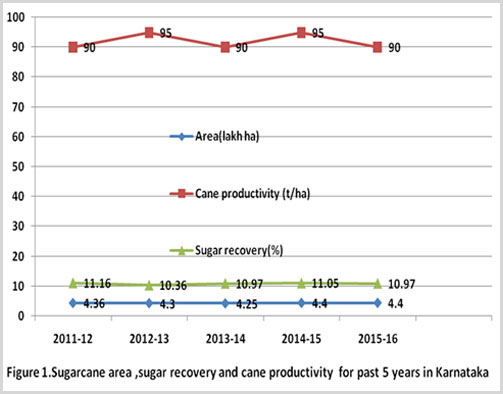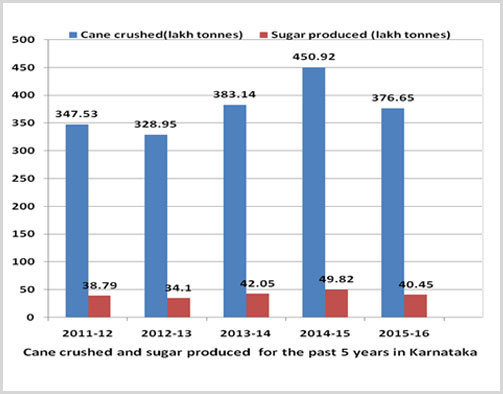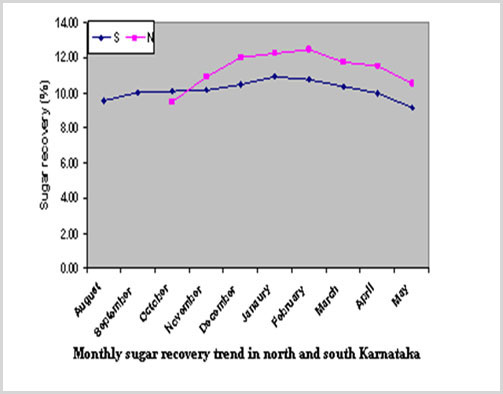
|
|||||||||||||||||||||||||
|
Sugarcane scenario in Karnataka
In India Karnataka stands 3rd in cane production next to Uttar Pradesh and Maharashtra States and 2nd with respect to sugar recovery after Maharashtra. Sugarcane is grown in 16 districts of the state. Belgaum, Bagalkot, Bijapur, Mandya, Mysore, Chamrajnagar and Bidar are the major sugarcane producing districts.
Figure 1 indicates sugarcane area, recovery and cane productivity for last five years in the state.
Figure 2 indicates cane crushed and sugar production for the last 5 years in the state.
3. Karnataka is bestowed with favourable agro-climatic conditions duly supplemented with suitable soils for sugarcane cultivation. There are number of perennial rivers with dams, reservoirs, bore-wells and open-wells to supply water for sugarcane cultivation. The northern part of the state Important sugarcane growing regions in the state are: 1. Southern & Coastal : High cane yield per ha and low sugar recovery(Mandya,Mysore,Hassan). 2. Central Karnataka: Medium to low yield and low recovery(Haveri,Davangere,Bellary,Gadag). 3. North west Karnataka : Medium cane yield and high sugar recovery(Belgaum and Bagalkot,Bijapur). 4. North east Karnataka: Low yield and medium recovery (Bidar,Gulburga)
The factors responsible for lower cane productivity in the state
1. Adverse effects of various biotic and a biotic stresses on sugarcane crop. 2. Use of imbalance and over/under use of chemical fertilizers. It is more relevant for the application of nitrogen to sugarcane. 3. Un-controlled and faulty irrigation schedules and methods for sugarcane. 4. Deterioration of soil physical characters due to poor drainage/no drainage systems for sugarcane fields. 5. Lesser/no use of organic manures in sugarcane cultivation including green manuring. 6. Less or no emphasis on use of bio-agents and bio-fertilizers in controlling sugarcane pest and diseases and also in cropping system of sugarcane. 7. Planting of poor quality cane seeds which are not from a definite source. 8. Adoption of un-scientific agronomic practices for sugarcane cultivation. 9. Ignorance of inter-cropping cultivation and measures to enhance soil productivity in sugarcane.
Region-wise agro-climatic and sugarcane features in the state
The main features of cane cultivation in Northern region.
I. The sugarcane productivity is in the range of 70-75 tonnes/ha. II. Sugarcane is grown mainly by utilizing the water from Canals, Bore-wells, and Open-wells, major and minor Lift irrigation schemes. The Canal irrigation is mainly provided during kharif and rabi seasons and there after water is supplemented to sugarcane by Bore-wells or Open-wells etc., III. The major plantation of sugarcane takes place in the month of September to November. However, sugarcane is planted from June to February in the region. IV. Sugar mills start their crushing operation in the month of October –November and depending upon the cane availability to crush the sugarcane till April-May. V. Most of the sugarcane area is covered under Co86032 which is a high cane yield and high sugar recovery variety. Co86032 is amenable to plant in different seasons due to its sparse & delayed flowering or no flowering character. VI. Harvesting and transportation charges are borne and arranged by the sugar mill. The sugar factories announce their sugarcane price on ex-gate basis. VII. By and large there is acute water shortage during summer season due to depleted water levels in the Open-wells and Bore-wells coupled with power shortage. VIII. The un-controlled and faulty irrigation schedules and methods for sugarcane especially during kharif season. Measures to increase sugar recovery in north Karnataka. I. Introduction of sugar rich varieties of sugarcane and replacement of low sugar varieties viz., Co8011, Co91010, Co740 etc. Need to rejuvenate the CoC671 for cultivation and introduce the high yield coupled with high sugar content genotypes. II. Optimize the age at harvest for different varieties particularly during early crushing and fag end of the crushing season. III. Adopting staggered plantation duly backed up with the three tier cane seed nursery programmers. IV. Providing tissue culture plantlets on large scale to the cane growers through sugar mills of elite varieties. V. Initiation of massive Cane Development and Extension activities near the vicinity of sugar mills. VI. Introducing /Improving sugarcane agro-techniques in the farmer’s field including irrigation facilities. VII. Minimizing cut to crush period by following suitable harvesting and transport schedules. VIII. Plugging up of weak areas pertaining to sugar recovery and improving the extraction efficiencies in the sugar mills. Strategies to enhance cane yield. A. Crop production technologies: i. Need to introduce new varieties which can give higher cane yield and sugar recovery at a faster rate. This is possible by taking trails in the R & D farm of sugar mills for the elite varieties. These trials are to be regularly monitored and steps are to be taken to multiply the proven varieties in the fields of progressive cane growers. A new model to take the action by involving industry, institute, university and farmers is to be worked out. ii. Establishment of tissue culture laboratory to supply breeder/foundation seed material to sugar mills and sugarcane growers: Providing grants to S.Nijalingappa Sugar Institute, Belagavi and Bharat ratna Sir M.Visvesvaraih Sugarcane Research Institute, Mandya for establishing tissue culture laboratories in north and south Karnataka respectively.iii. Factory level > Installation of Hot air treatment units/aerated steam therapy units and adoption of three tier seed nursery programmer by utilizing tissue culture seedlings. > Field trials/demonstrations of new varieties and conducting big mill tests. > Continuous monitoring and up gradation of harvesters in the areas of sugar mills. > Extensive training and campaign on seed cane and application of balance fertilizers. > Adoption of wider-row technology and Ratoon Management. > Computerization and use of modern tools in cane management for overall efficiency. > Popularization of trash management. Main features Cane cultivation in Southern region • The sugarcane productivity is in the range of 100-110 tonnes/ha. • Sugarcane is cultivated mainly by utilizing KRS (Krishna Sagar) dam water, which normally supplements the water required for sugarcane for all its growth period. • There are plots having low-lying areas and surrounded by many paddy fields. • Except Haveri and Davanagere districts (central part of the state) in other area sugarcane is mainly planted in June-August and minor area is covered during Jan-February. • Sugar mills start their crushing operation in July – August and close during May-June depending upon cane availability. • Majority of the area is covered under Co62175, which is a high cane yield and low sugar recovery variety. However, wherever sugar mills have initiated cane development activities there is substantial area occupied by Co86032, which is a high sugar variety, compared to Co62175. • Harvesting and transportation charges are borne by sugarcane farmer and sugarcane price is fixed on ex-field basis. • Many areas nearby sugar mills are not tapped with sugarcane, as there is lack of extensive cane development activities from sugar mills. • Absence of interior road is a limitation for transport of cane from field to sugar factory. • By and large smaller land holdings and sugarcane area is not compact. Sugar recovery in Karnataka Cooler temperatures & long rights in case of Northern region of Karnataka during December to March help to increase sugar recovery in sugarcane. These conditions are favorable for more sugar accumulation regardless of variety and age at harvest. Therefore, the trend of sugar recovery in northern region is higher (11.0 to 11.5%). The recovery during October-November is lower and it is increases as the crushing season advances. The peak recovery is attained in the month of February-March and during fag-end of the crushing season i.e., in April-May there is sharp decline in sugar recovery.
1. Sugarcane varieties: Predominant variety is Co62175 2. Climate: Less cooler nights during harvesting period of sugarcane 3. Harvesting season: June to May (June to October is not conducive) Regardless of the variety and agro-techniques adopted there is further scope to manipulate the sugar recovery of a sugar mill by adopting the following measures on a sustainable basis in south Karnataka. 1. Introduction of sugar rich varieties of sugarcane. There is a need to identify a suitable variety which can replace the rulling Co62175. 2. Adopting staggered plantation dully backed up with the three tier cane seed nurseries. 3. Providing tissue culture plantlets on large scale to the cane growers through sugar mills of elite varieties. 4. Initiation of massive Cane Development and Extension activities near the vicinity of sugar mills. 5. Introducing /improving sugarcane agro-techniques in the farmer’s field including irrigation facilities. 6. Minimizing cut to crush period by following suitable harvesting and transport schedules. 7. Plugging up of weak areas pertaining to sugar recovery and improving the extraction efficiencies in the sugar mills. In case of southern region the sugar recovery is lower (9.0 to 9.5%). The lower recovery in south Karnataka is mainly attributed to the following reasons.
| |||||||||||||||||||||||||
|


